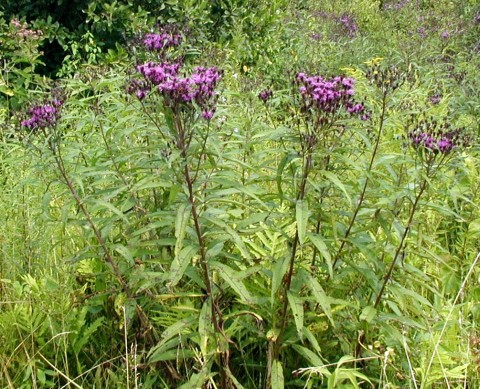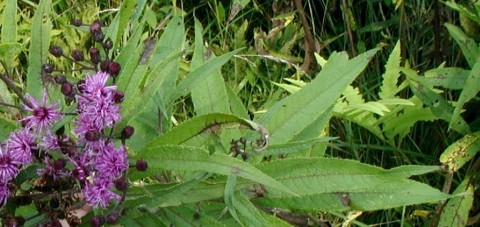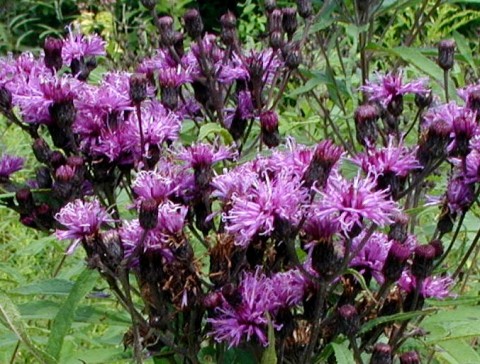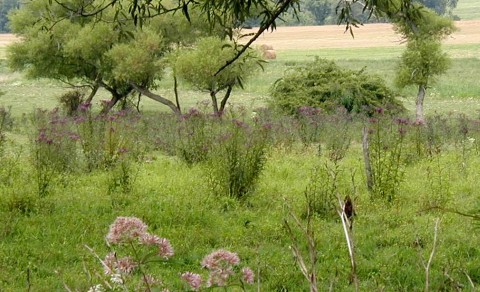Once you see the deep, dark purple of New York Ironweed flowers, you’ll be on the lookout for them at Summer’s end each year.
About the middle of August we start seeing the 3-4 feet tall “weeds” along the county roads near the places where goldenrods and asters show off their colors, especially in wetter areas near culverts and along river bottoms.

Standing 3-4 feet tall, NY Ironweed is typically found in old pastures and waste places. Photos taken 14 August 2008.

Looking down on the long, pointed lance-shaped leaves of New York Ironweed.

The flowers of New York Ironweed are a much deeper violet color than what this photo shows.
New York Ironweed, Vernonia noveboracensis, gets its common name from the toughness of the stem – it’s like iron. Just try and break off a stem to take a piece with you!
New York Ironweed differs from Tall Ironweed, V. altissima, by having long threadlike bracts on the flower head base and 30-50 flowers in each head. Tall Ironweed has short-pointed bracts and fewer flowers in the flower head, approximately 13-30 flowers. Both are rayless members of the Composite family.

New York Ironweed stands tall in this cow pasture. Apparently the cows won’t eat it.
Native Americans made use of an ironweed root tea for the treatment of irregular menses, bleeding, and stomach upset.
I observed this plant August 7, 2009 growing in Allentown, PA at the scenic Haines Mill Park. There were many patches of it along the stream, at least 5 feet tall and some closer to 7 feet tall. We have had a very damp summer so far. This plant was new for me and it took me a lot of research in my wildflower texts to find it. The electric purple of the blossoms makes it a show stopper. Gorgeous up close.
Hey Beverly,
I agree! The deep purple of the New York Iron Weed is truly gorgeous. The photos shown here were taken in a low-lying area near a small creek that drains a pasture. Must have been a real sunny day because the pictures are very washed out. In real life the purple really is the deepest!
Thanks for letting us know where and when you saw the plants.
We have various types of ironweed here in southern Ohio and it always seems to grow alongside the tall yellow flowers of the evening primrose and these two flowers compliment each other well. Then there is also the tall paler violet/pink Joe Pye Weed. I thought your last photo looked like Joe Pye Weed. Anyway, thanks for the beautiful photos.
Hi Fran,
I’d like to see the evening primrose yellow flowers alongside the purple ironweed. It must be beautiful.
Yes, you are right. In the last photo the plants in the foreground with the lighter purple-pink blossoms are Joe Pye Weed, and in the background you can see the ironweeds are taller than the surrounding “grass”. You can just make out their dark purple blossoms.
Thanks for stopping by!
I have adored ny ironweed for years. I would like to get ahold of a plant or two. Any suggestions. I like the thought of using primroses with them, I have also thought of using loostrife, any suggestions about getting ahold of that ‘controlled’ species also? Thanks for your time.
Hey Stephanie,
The easiest way to get a plant or two of either of these ‘roadside weeds’ would be to make a midnight collection from the road. Actually, I don’t wait to midnight to collect the interesting plants I find along the road as I want to know where I’m stepping and what else may be growing nearby. I just try to locate plants of interest along backroads or places not that well traveled and pick up a few. Take some plastics bags for your collection – they hold the loose dirt and roots pretty well.
If it is obviously a location where somebody lives, I’d ask for permission first. You might be surprised how many people don’t know what they have growing in their own backyard, so you’ll have a chance to enlighten them. Don’t take specimens from state parks or national forests, and by all means pull well off the road so you don’t interfere with other vehicles.
I wouldn’t collect purple loosestrife. It really is an invasive plant that has overtaken many native plants. You can see this for yourself by taking note of the locations where you see it this year and then, take a look next year. Most likely there will be lots more. Even though it’s pretty, try to enjoy it from a distance.
I have collected several seeds from the ironweeds that beautifuly covered our hillside. We had hundreds if not thousands of various butterflies this year because of the bright purple flowers and yellow flowers of the yellow wingstem. I would be interested in selling these seeds for as little as $2.00 including s/h min order of 3 packs. Contact me at conniewilloughby@msn.com
Hey Connie,
Aren’t they lovely deep purple flowers? NY Iron Weed blooms every year in this one patch that I regularly drive by. I look forward to seeing their deep purple near the end of summer. It’s great to know that they’re butterfly attractors!
Is your NY ironweed planted in a moist or shady area? The patches I see along the road get full sun.
Are you located in the east? Curious where your weeds are at!
I found a NY ironweed in Michigan on our farm! I dug up the whole plant and moved it to my butterfly flower garden. I hope it will survive the move.
It was in an old hay field – full sun. Not near water or overly moist.
That’s cool, Rose. I’ll bet the ironweed will make the move just fine. Seems like it needs the full sun to flourish so your butterfly garden will be great for it. 🙂
I have some NY Ironweed growing around my property, here in eastern TN, for the first time that I can remember.
Hi Matt,
I’ve seen NY Ironweed growing in the same places for a number of years now that I’ve been noticing them. Perhaps you will too as it’s a perennial.
The populations in Ohio and Kentucky are apparently decimated and of special concern, so it’s really nice to hear about a new population of this interesting plant.
Thanks for letting us know!